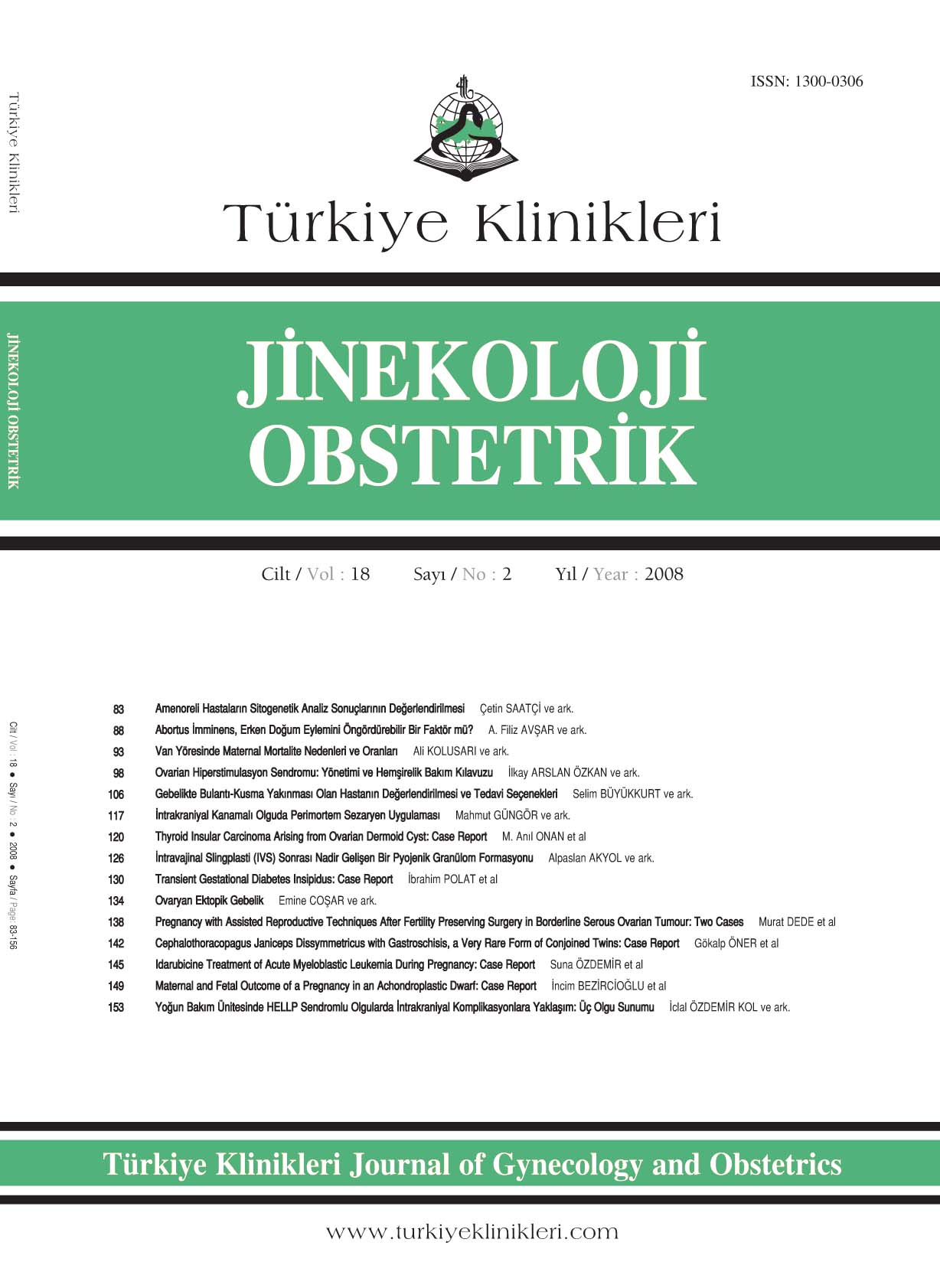Open Access
Peer Reviewed
CASE REPORTS
3734 Viewed1305 Downloaded
Performing of Perimortem Cesarean Section on a Patient with Intracranial Hemorrhage: Case Report
İntrakraniyal Kanamalı Olguda Perimortem Sezaryen Uygulaması
Turkiye Klinikleri J Gynecol Obst. 2008;18(2):117-9
Article Language: TR
Copyright Ⓒ 2025 by Türkiye Klinikleri. This is an open access article under the CC BY-NC-ND license (http://creativecommons.org/licenses/by-nc-nd/4.0/)
ÖZET
Perimortem C/S ile doğum; ilk olarak 1986 yılında tanımlanmış olup maternal kardiyopulmoner resusitasyon (CPR) sırasında uygulanan C/S ile doğumdur. 36 yaşında intrakraniyal hemoraji nedeniyle arrest olan 36 haftalık multipar gebeye; 60.dakikada CPR sırasında merkezimizin acil servisinde perimortem sezeryan uygulaması yapıldı. Doğum öncesi yaptığımız USG de fetal kardiyak aktivite izlenmemesine rağmen doğumdan sonra bebek 36 saat prematür yoğun bakım servisinde yaşadı. Anne perimortem sezeryan öncesi CPR sırasında kalp ritmi nabızsız elektiriksel aktivite olarak gözlenirken, doğumdan sonra kalp ritmi ventriküler fibrilasyon olarak izlendi. Defibrilasyona rağmen annenin periferik nabzının alınamaması üzerine hastaya torakotomi yapılarak açık kalp masajı uygulandı. Uygulama sonrası annenin periferik nabzı:121/dk ve TA:148/90 mmHg olarak ölçüldü. Hasta 2 saat 45 dk. yaşatıldıktan sonra tekrarlanan CPR'a cevap vermemesi üzerine eksitus olarak kabul edildi. Perimortem C/S uygulamasında; arrest ile yapılacak olan C/S arası geçen süre, gestasyonel hafta, fetal kardiak aktivite varlığı ve kardiak arest'i takiben sürekli CPR yapılması prognozu etkileyen en önemli faktörlerdir.
Perimortem C/S ile doğum; ilk olarak 1986 yılında tanımlanmış olup maternal kardiyopulmoner resusitasyon (CPR) sırasında uygulanan C/S ile doğumdur. 36 yaşında intrakraniyal hemoraji nedeniyle arrest olan 36 haftalık multipar gebeye; 60.dakikada CPR sırasında merkezimizin acil servisinde perimortem sezeryan uygulaması yapıldı. Doğum öncesi yaptığımız USG de fetal kardiyak aktivite izlenmemesine rağmen doğumdan sonra bebek 36 saat prematür yoğun bakım servisinde yaşadı. Anne perimortem sezeryan öncesi CPR sırasında kalp ritmi nabızsız elektiriksel aktivite olarak gözlenirken, doğumdan sonra kalp ritmi ventriküler fibrilasyon olarak izlendi. Defibrilasyona rağmen annenin periferik nabzının alınamaması üzerine hastaya torakotomi yapılarak açık kalp masajı uygulandı. Uygulama sonrası annenin periferik nabzı:121/dk ve TA:148/90 mmHg olarak ölçüldü. Hasta 2 saat 45 dk. yaşatıldıktan sonra tekrarlanan CPR'a cevap vermemesi üzerine eksitus olarak kabul edildi. Perimortem C/S uygulamasında; arrest ile yapılacak olan C/S arası geçen süre, gestasyonel hafta, fetal kardiak aktivite varlığı ve kardiak arest'i takiben sürekli CPR yapılması prognozu etkileyen en önemli faktörlerdir.
ANAHTAR KELİMELER: Sezaryen, kardiyopulmoner canlandırma, intrakraniyal kanama
ABSTRACT
The term of perimortem cesarean delivery was introduced first in 1986 to refer to the delivery through the application of cesarean section during maternal cardiopulmonary resuscitation (CPR). Perimortem cesarean section was performed at the 60th minute of arrest on a 36-year-old multiparous pregnant woman who was at the 36th week of gestation and went into cardiac arrest because of intracranial hemorrhage. Although, the USG scan that was performed before the delivery did not reveal fetal cardiac activity, the infant was kept alive for 36 hours in the intensive care unit. Before the perimortem cesarean section, the premature heart rhythm of the mother turned into pulseless electrical activity and ventricular fibrillation was observed after the delivery. Despite the defibrillation, thoracotomy was performed and open cardiac massage was applied subsequently since "the mother had no pulse". After the application, the pulse rate of the mother was determined as 121/min and arterial pressure (AP) was 148/90 mm Hg. The patient was kept alive for 2 hours and 45 minutes and was declared clinically dead since she did not respond to CPR. The interval between cardiac arrest and cesarean section, gestational week, the presence of fetal cardiac activity and the performance of continuous CPR following cardiac arrest are the most significant factors that affect prognosis in the application of perimortem cesarean section.
The term of perimortem cesarean delivery was introduced first in 1986 to refer to the delivery through the application of cesarean section during maternal cardiopulmonary resuscitation (CPR). Perimortem cesarean section was performed at the 60th minute of arrest on a 36-year-old multiparous pregnant woman who was at the 36th week of gestation and went into cardiac arrest because of intracranial hemorrhage. Although, the USG scan that was performed before the delivery did not reveal fetal cardiac activity, the infant was kept alive for 36 hours in the intensive care unit. Before the perimortem cesarean section, the premature heart rhythm of the mother turned into pulseless electrical activity and ventricular fibrillation was observed after the delivery. Despite the defibrillation, thoracotomy was performed and open cardiac massage was applied subsequently since "the mother had no pulse". After the application, the pulse rate of the mother was determined as 121/min and arterial pressure (AP) was 148/90 mm Hg. The patient was kept alive for 2 hours and 45 minutes and was declared clinically dead since she did not respond to CPR. The interval between cardiac arrest and cesarean section, gestational week, the presence of fetal cardiac activity and the performance of continuous CPR following cardiac arrest are the most significant factors that affect prognosis in the application of perimortem cesarean section.
MENU
POPULAR ARTICLES
MOST DOWNLOADED ARTICLES





This journal is licensed under a Creative Commons Attribution-NonCommercial-NoDerivatives 4.0 International License.










